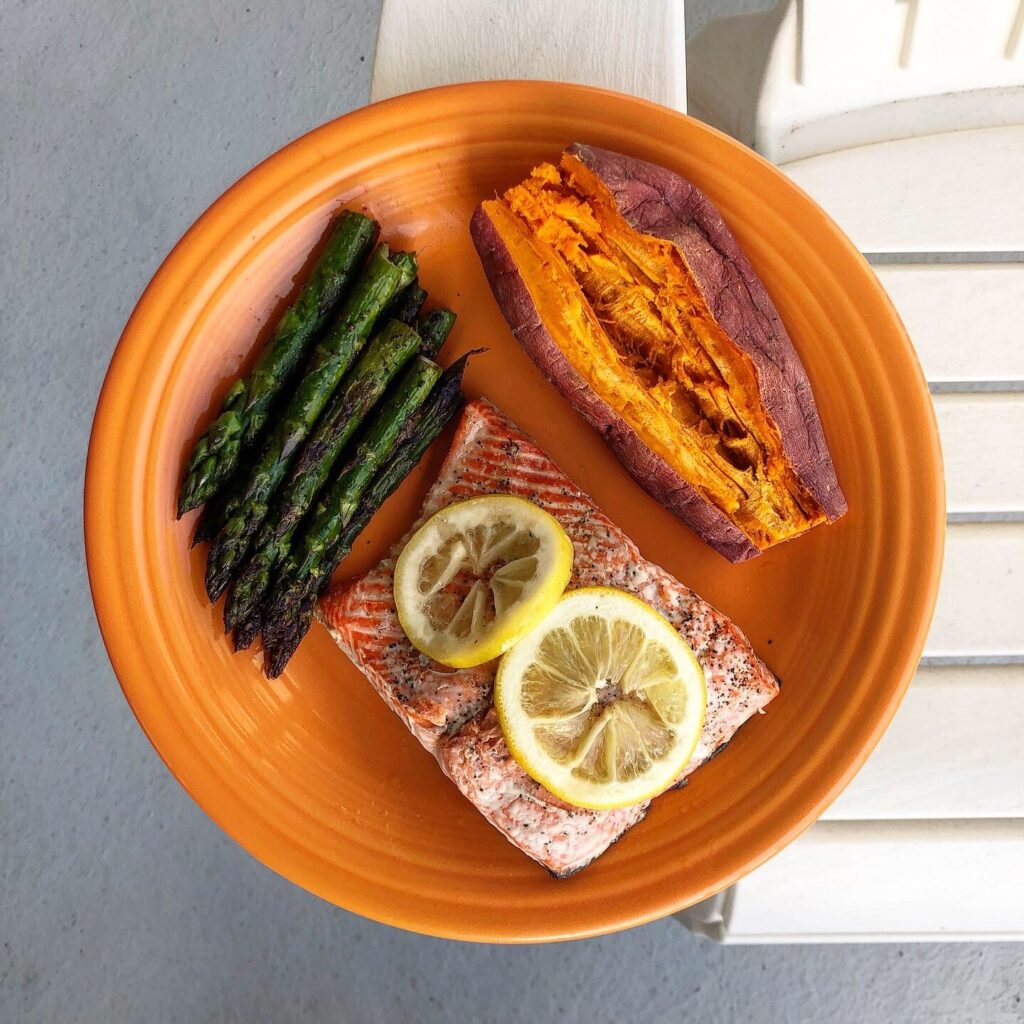We’re all constantly being told what to do, what we’re doing wrong, and or how to do something better. Many times those messages are opinion-based and unreliable. And other times they’re science-based, but overwhelming and potentially even unrealistic to follow. In our case, after decades of working in the fitness space, seeing it and hearing it all, we like a blended approach of opinion and science, or as we like to consider it: art and science.
Fitness is something that’s incredibly personal. We’re all built differently, move differently, and lead different lives and lifestyles. It’s impossible to create one absolutely-perfect plan for everyone, but in our opinion there is a way to design a very strong foundation for one.
Whether you’re feeling it’s time to reset and restart your fitness, or simply optimize what you’re already doing with a new approach, read on.
Related: 35+ free workout plans for different goals and ability levels
Eat cleaner. Get leaner.
The Fat Loss Meal Planner helps you build high-protein, macro-aligned meals that actually support your body — and your goals.
Your High Performance Workout Plan Overview
In developing this workout plan, we considered the following: strength, power, mobility, heart health, and recovery. Those are essentials.
Strength training is the base of any high performer’s programming. We’ve designed three days of workouts that cover all the major muscle groups.
And considering that research shows power begins to decline by 1% each year after 35, we’ve designed a HIIT (high intensity interval training) and metabolic conditioning workout that incorporates movements that enable you to be explosive and move fast.
As for heart health, 150 minutes of moderate intensity cardio (or 75 minutes of vigorous or a combo of the two) per week is the recommended amount according to the Physical Activity Guidelines for Americans. So, we’ve programmed in one low and slow cardio day within the program along with that day of HIIT training, and if you’re walking daily, you should be able to reach that threshold.
And as far as recovery and mobility goes, we’ve provided a pre-workout warm-up to prepare your body for action and a post-workout stretch to support recovery. We’ve also included a couple days per week of low intensity activities to ensure the body has the time it needs to fully recover.

Your High Performance Workout Schedule
Monday: Strength (Full Body)
Tuesday: Low Intensity Activities & Stretching
Wednesday: HIIT / Metabolic Conditioning / Power
Thursday: Strength (Full Body)
Friday: Low Intensity Activities & Stretching
Saturday: Strength (Full Body)
Sunday: Long & Slow Cardio
Your Pre-Workout Dynamic Warm-Up Routine (10 minutes)
Strength Days
World’s Greatest Stretch x 5 each side
Cat Cow x 5
Lateral Lunge x 10 each side
Bodyweight Squat x 10
Lateral Lunge x 10 each side
Push-ups x 5
Superman x 10
Plank hold x 20 seconds
HIIT/Cardio Days
World’s Greatest Stretch x 5 each side
Cat Cow x 5
Lateral Lunge x 10 each side
High Knees x 20 seconds
Butt Kicks x 20 seconds
Plank hold x 20 seconds
Your Post-Workout Static Stretching Routine (12 minutes)
Repeat 2x
Forward Fold x 1 minute
Seated Twist x 1 minute each side
Frog Stretch x 1 minute
Pigeon Pose x 1 minute
Lat Stretch x 1 minute
Pec Stretch x 1 minute
Your High Performance Workouts

Complete the following workouts for 6 – 8 weeks. Each week, attempt to slightly increase the amount of resistance you use for the strength exercises. On HIIT / metabolic conditioning days, attempt to move slightly more quickly and/or efficiently. On the long and slow cardio days, increase your distance or time spent. Incremental increases should not exceed 10% each week.
After the eighth week, reduce your efforts by 20 – 30% for one week. Repeat the cycle.
Monday: Strength (Full Body)
Complete the exercise below as straight sets, one after the next before moving onto the next exercise. Rest 45 seconds between sets.
Plank 5 sets x maximum hold
Weighted Squat (of choice) 5 sets x 10-12 repetitions
Bent-over Row 5 sets x 10-12 repetitions
Chest Press 5 sets x 10-12 repetitions
Biceps Curl 5 sets x 10-12 repetitions
Triceps Pushdown 5 sets x 10-12 repetitions
Tuesday: Low Intensity Activities (e.g. easy bike ride, hike, etc.) & Stretching
Wednesday: HIIT / Metabolic Conditioning / Power
Perform as many rounds as possible in 12 minutes
Thruster x 5-10 repetitions
Mountain climber x 5-10 repetitions
Lunges x 5-10 repetitions
Push-Ups x 5-10 repetitions
Squat Thrust x 5-10 repetitions
Jumping Jack x 1 minutes
Thursday: Strength (Full Body)
Complete the exercise below as straight sets, one after the next before moving onto the next exercise. Rest 45 seconds between sets.
Hollow Hold 5 sets x maximum hold
Lunges (Forward or Reverse) 5 sets x 10-12 repetitions
Lat Pulldown 5 sets x 10-12 repetitions
Overhead Press 5 sets x 10-12 repetitions
Hammer Curl 5 sets x 10-12 repetitions
Triceps Skull-crusher 5 sets x 10-12 repetitions
Friday: Low Intensity Activities (e.g. easy bike ride, hike, etc.) & Stretching
Saturday: Strength (Full Body)
Complete the exercise below as straight sets, one after the next before moving onto the next exercise. Rest 45 seconds between sets.
Bird Dog Row 3-5 sets x 10-12 repetitions
Leg Extension 3-5 sets x 10-12 repetitions
Leg Curl 3-5 sets x 10-12 repetitions
Pull-Up 3-5 sets x maximum repetitions
Push-Ups 3-5 sets x maximum repetitions
High Pull 3-5 sets x 10-12 repetitions
Eccentric Biceps Curl 3-5 sets x 10-12 repetitions
Eccentric Triceps Push-down 3-5 sets x 10-12 repetitions
Sunday: Long & Slow Cardio
30,45, or 60+ minutes of Zone 2 cardio of choice (e.g. run, row, bike, etc.)
Your High Performance Meal Plan

When it comes to nutrition, things get a bit more nuanced based on the individual. For general fitness, we like to consume 40% protein, 40% carbohydrate, and 20% fat in each of our meals, with some generous wiggle room on the percentages. That’s what seems to work best for body composition and day to day performance. However, it’s important to note that endurance athletes, such as triathletes, or hybrid athletes (those who do HYROX, Spartan Races, Tough Mudders, etc.), those numbers will look a lot different. Those types of athletes would need significantly more carbohydrates. Another consideration is everyone’s starting points are different and would change the total amount of food needed. Still, here’s a sample meal plan that looks a lot like what we eat daily.
Breakfast
Eggs (combination of whole & whites), oatmeal and/or whole grain toast, side of avocado
Snack
Mix nuts of choice
Lunch
Mixed greens salad with grilled chicken, tofu, or fish with two to three vegetable toppings, quinoa or brown rice, extra virgin olive oil
Snack
Performance Pudding: Protein powder, chia seeds, oatmeal, Greek yogurt, unsweetened almond milk, water
Dinner
Grilled chicken breast, turkey, or fish, brown rice or sweet potato, vegetable of choice
Your Deep Sleep, Low Stress Plan
Long gone are the days of operating on limited sleep and wearing it like a badge of honor. Quality sleep is non-negotiable for performance since it allows the body to rest, repair, and rebuild.
Related: A perfect day of recovery for high performers
Out Cold
There are a few ways to set yourself up for better sleep at night that include winding down from stimulating conversations close to bedtime, not eating too close to bedtime, turning off phones, and blacking out the room from light. But one of the simplest ones, that’s quite easy to be consistent with, is turning the thermostat down. Our bodies need a core temperature drop to sleep well, and numerous sleep studies and research show that cooler (but not too cool) are best for sleep. In fact, the Cleveland Clinic recommends temperatures between 60-67 are best for quality sleep. And, temperatures above 75 or below 54 are disruptive.
Breathe Easy
The American Psychological Association has extensively broken down how stress affects every system in the body. Their suggestions for combating it: regular exercise, eating well, good sleep, and stress reduction techniques. One such technique that we’ve found to be helpful is 4-7-8 breathing. Inhale for 4 seconds, hold for 7 seconds, exhale for 8 seconds. Focus on breathing into the belly and not in the chest. Inhales are from the nose, exhales are out of the mouth. We also encourage daily morning meditation and journaling.
For more program options, check out our collection of 35+ free workout plans for different goals and ability levels.


